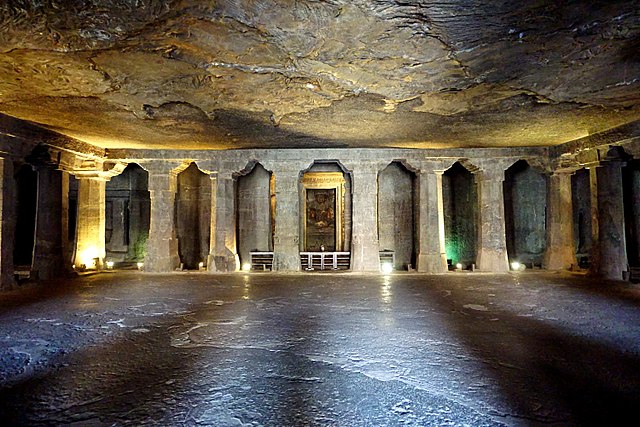Vihāra generally refers to a Buddhist monastery for Buddhist renunciates, mostly in the Indian subcontinent. The concept is ancient and in early Sanskrit and Pali texts, it meant any arrangement of space or facilities for dwellings. The term evolved into an architectural concept wherein it refers to living quarters for monks with an open shared space or courtyard, particularly in Buddhism. The term is also found in Ajivika, Hindu and Jain monastic literature, usually referring to temporary refuge for wandering monks or nuns during the annual Indian monsoons. In modern Jainism, the monks continue to wander from town to town except during the rainy season (chaturmasya), and the term "vihara" refers to their wanderings.
Kanha Cave vihara in the Nasik Caves, 1st century BCE, is one of the earliest.
5th century Cave 4 at the Ajanta Caves with a Buddha statue in the centre shrine cell.
Cave 12, Ellora, a late multi-story rock-cut vihara. Further decoration of the pillars was probably intended.
Plan of cave 1 at Ajanta, a large vihara hall for prayer and living, 5th century
Buddhist monasticism is one of the earliest surviving forms of organized monasticism and one of the fundamental institutions of Buddhism. Monks and nuns, called bhikkhu and bhikkhuni, are responsible for the preservation and dissemination of the Buddha's teaching and the guidance of Buddhist lay people. Three surviving traditions of monastic discipline (Vinaya), govern modern monastic life in different regional traditions: Theravada, Dharmaguptaka, and Mulasarvastivada.
Monks outside the temple at the Tibetan Buddhist monastery, Rato Dratsang, in India, January 2015.
At the peak of its power, Japan's Enryaku-ji was a huge complex of as many as 3,000 sub-temples and a powerful army of warrior monks (僧兵, sōhei).
Young Buddhist monks in Tibet practising formal debating
A Buddhist monk in Kaohsiung, Taiwan, wearing the robes of an abbot in a monastery








